Question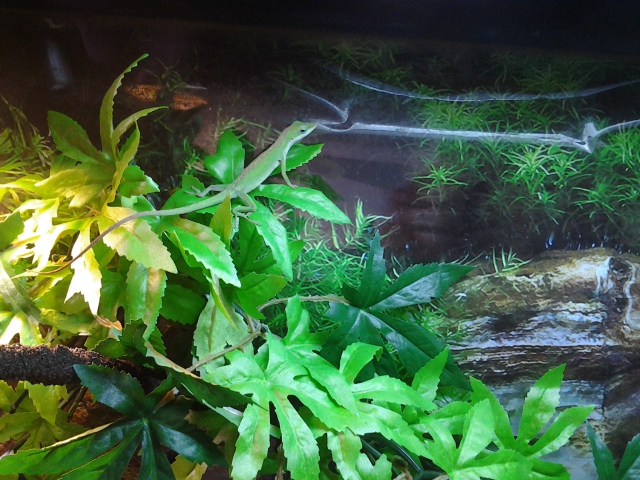 anole color
anole color
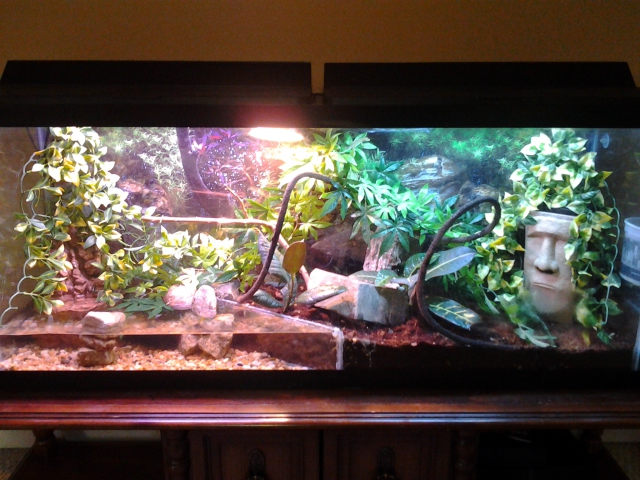 my tank
my tank
QUESTION: hey donna i have a few questions to ask about my green anole. I have a 55 gallon long terrarium or vivarium made up for my anole, which includes a nice water feature (half water, half land), with a repti-sun basking bulb, a 18 inch uvb bulb and a 18 inch full spectrm bulb. Iv got alot of fake plants and vines and a few live plants aswell. I use exo-terra plantation soil. Iv got rocks, a waterfall and a submersable filter for the water feature. I also got a few neon tetas for the water side. My anole is very attractive in colour all the time. The only thing i worry about is, she has a small lump on his/her side that it has had since the day i bought him/her. The lump has not gotten any bigger or smaller. Iv heard maybe its an absess or its a sign of MBD. I dust the feeder crickets every time i feed her which is usually every other day. Also when i bought the poor thing it looked really skinny,but had a huge appitite the day a brought it home. The temps are all good the humidity is always right up there. Also just recently i noticed when i spray the tank to make dropplets for the lizard to drink, the humidity rises of course and leaves condensation on the glass, but if you look really really closely at the condensation you can see these little trails in it. If you follow the trails you can find these really really really really tiny little white bugs and they move really slowly...i looked it up but got no real answer. They are so small you can hardly see them. Are these bad for my lizard and if so how do i eliminate them. Ill attach pics for you below
ANSWER: It's a wonderful enclosure for an anole--however, you would have done well to quarantine her in a minimal setup, and have a vet test and treat her for parasites before putting her into it. Be sure that no lights are in the cage that get hot, that she might touch. Be sure she can get to within 6 inches (preferably 4 inches) of the UVB light, to bask, or it does no good.
She looks pretty good. Without being able to see the lump on her side, I can only guess. It could be an old injury (anoles are pretty much always wild-caught). It could be a filarial worm under the skin.
---------- FOLLOW-UP ----------
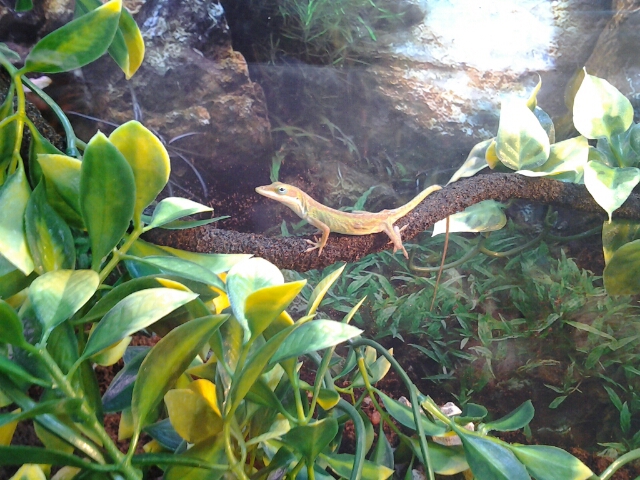 the luuuuump
the luuuuump
QUESTION: Ya i know the light shouldnt be in there but i havnt got a screen lid for her yet cuz they cost about 80-90$ for one that size....i didnt know about quarantining her only because the pet shops never tell you to do that and this is my first reptile. Umm if its a worm under her skin would it move around. Or maybe even pop out eventually?......also can you tell if its male or female by the picture....id like to know :-) ......And also what about the little bugs in the condensation thanks.
Also iv attached a picture of the lump...its the best i could do because she is really camera shy
Mat
AnswerShe still looks a bit thin. (Yes, it is a female). Females will do some head-bobbing, but they do not possess the large, colorful throat-fan that the males have. They also have a shorter, smaller head, and an irregular light-colored line down their back. Males will have a larger head, no light-colored line, and will have a brightly-colored throat-fan that they can display, as well as a nuchal crest (they can raise the flesh along their spine in a ridge, when displaying). Multiple females can often get along together, but only one male can be kept in an enclosure, as they will fight other males viciously.
I still can't tell whether the lump is an injury, or filarial worm. (If it's a worm, it will actually look like a worm under the skin). They can move around under the skin, but they won't emerge on their own. They have to be removed (not pleasant).
Here's an example: http://t3.gstatic.com/images?q=tbn:ANd9GcRR0_tjJ5HrX1M7JweBCU34VvOpkmxgnpnaP7xA9
(Enlarge the photo, and you can see the worm under the skin on the chameleon's side). If it is an old injury, there isn't really anything to be done about it.
The bugs probably came in on the live plants, and are probably some sort of mite--without seeing them, I'm just guessing. They aren't harmful to your lizard. Reptile mites would be seen on the lizard, and are usually red or black.
I recommend a little elevated platform (they make some that are magnetic, or that attach with velcro), and offering her some Repashy crested gecko diet in addition to the calcium-dusted insects. If she is uninterested, try peach baby food--if that's accepted, mix it with the Repashy and slowly decrease the amount of peach over time until she's eating it straight. It will do a lot to improve her health, and increase her weight and activity level. Be sure to mist several times per day, good hydration will also help her to acclimate and recover from her ordeal.
Keeping the cage very clean will help with preventing reinfection with the internal parasites she undoubtedly carries. Since your enclosure is so large, you can afford to wait a bit before deparasitizing her, but eventually you will want to have a vet check her for internal parasites, and medicate her to eliminate them. At that time, you'll have to break down the enclosure, and disinfect everything in it with bleach solution. She can be kept on simple paper towel with a fake plant during the treatment period. (Live plants would have to be replaced).
If you plan to add more anoles to the enclosure, quarantine them in a 10 gallon on paper towel with a fake plant, which you can disinfect daily, until they're through de-parasitizing treatment.
If you do not deparasitize them, then it's likely that they will eventually succumb to their parasites, as parasites build up to lethal levels in a captive situation, due to reinfection. (In the wild, they don't spend much time around their own feces, but in captivity, they will be constantly walking through the parasite eggs and larvae that are shed in them). Green anoles have a lifespan of 5 to 8 years with proper care.
These are hardy little animals, and she could live for years even if you do not deparasitize her, if you keep things reasonably clean in there--it is a very large enclosure. (If that is a filarial worm, it will need to be removed, though). You will need to decide how far you want to go. The deparasitizing process is also stressful. It may be 6 months before she's fully acclimated (adapted to living in captivity, and recovered from the ordeal of being captured). It's a shame, but some folks consider these little animals 'disposable' (something no live animal should be) due to their price tag. (As you've already learned, the true price of a reptile is often in its housing and care, not in its actual price). They are among my favorite lizards, for their personality and interesting behavior. Green anoles (our only native anole in the US) are suffering massive habitat loss and competition from invasive species, in the wild, and have been driven out of a lot of their former range by the more aggressive, introduced brown and cuban anoles.
It's also very much a good idea if you have any ideas about breeding them (acquiring a male, and hatching eggs). With the parasites gone, the hatchlings will also not be in danger of being exposed, if they hatch in the enclosure.




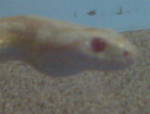 What is wrong
Question
pic of snake
My Husband bought me a albino Cal
What is wrong
Question
pic of snake
My Husband bought me a albino Cal
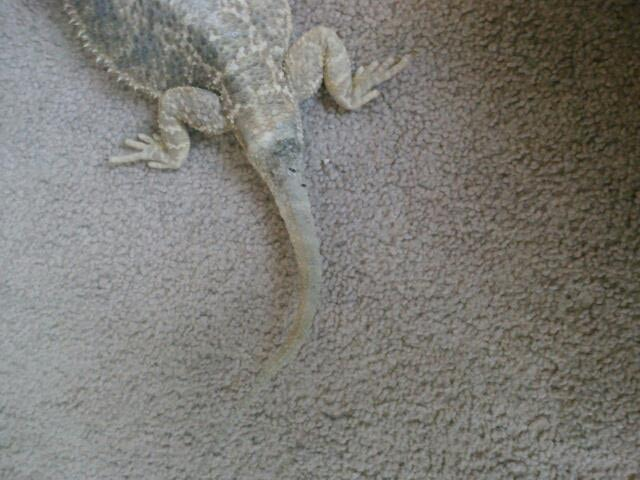 my bearded dragons tail is dead
QuestionSonyas tail
QUESTION: Sonya; my bearded
my bearded dragons tail is dead
QuestionSonyas tail
QUESTION: Sonya; my bearded
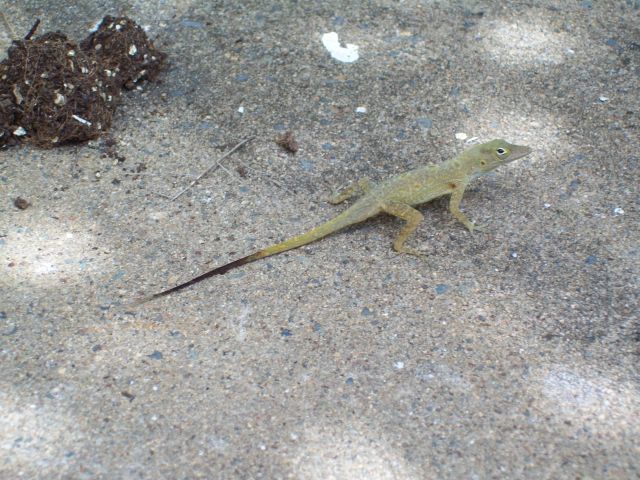 identifying lizards
Question
lizard
I live on the island of St. Thomas and
identifying lizards
Question
lizard
I live on the island of St. Thomas and
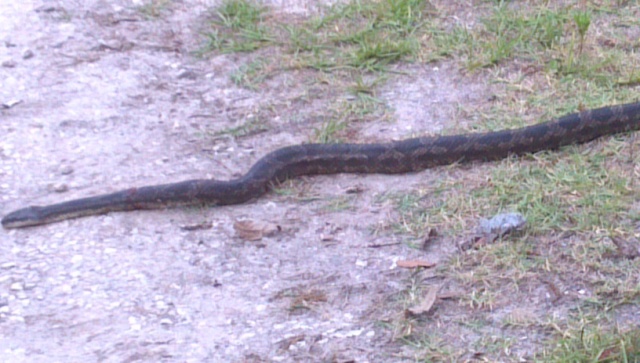 snake curled up in my back tire
Question
pic 1
Hello, I would like to know what
snake curled up in my back tire
Question
pic 1
Hello, I would like to know what
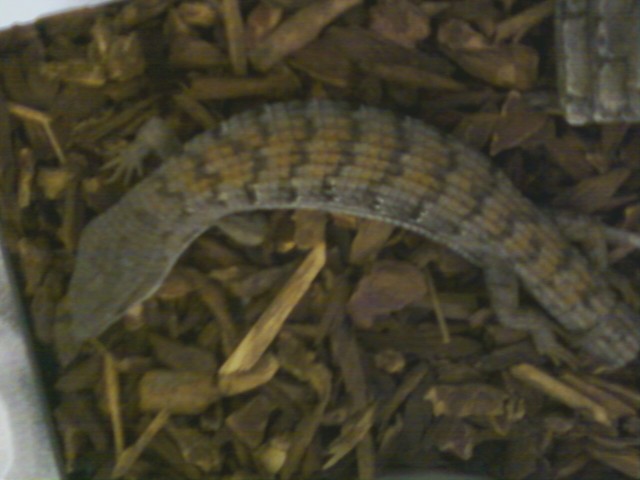 southern alligator lizard-paralysis
Question
Siggy sleeping
Hi, I just found an alligator l
southern alligator lizard-paralysis
Question
Siggy sleeping
Hi, I just found an alligator l